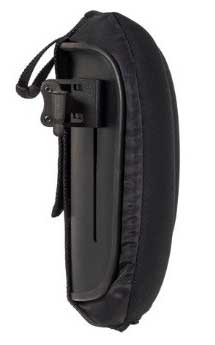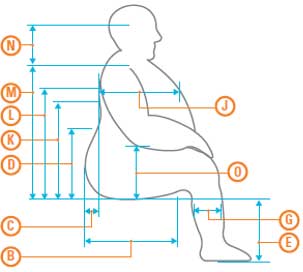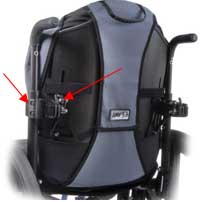There is a plethora of prefabricated (off-the-shelf) wheelchair back supports on the market today. As a clinician, recommending the correct type of back support is only half the battle. Together with your equipment specialist (e.g. RTS, ATP, and/or manufacturer representative) you also need to make sure it is sized and set up appropriately to meet your client's needs.
I have found that length and width, as well as angle and height, can each create their own set of measurement stumbling blocks, especially for a clinician who is new to seating and wheeled mobility. In this blog I am going to focus on height and length. As a first step, I'm going to clarify some terms, referencing two 2013 publications, Glossary of Wheelchair Terms and Definitions1 and A Clinical Application Guide to Standardized Wheelchair Seating Measures of the Body and Seating Support Surfaces, Revised Edition2, which are both based on current RESNA Standards-based terminology. Both resources are available as PDFs at no charge via the University of Colorado - Denver.
Backrest versus Back Support
Although the term "backrest" is still widely used, per ISO and RESNA standards, the correct term is "back support."1, 2 The Glossary of Wheelchair Terms and Definitions is a great resource to get up to speed with suggested, correct terminology. It lists and defines not only current terms, but also all related deprecated terms (old terms being phased out). Newer graduates, especially those from schools with strong Assistive Technology curricula, have a leg up on us older therapists - they are learning correct terms from the start instead of having to unlearn/relearn! I feel the need to interject here that following ISO or RESNA standards is voluntary on the part of the manufacturer. Further, if a manufacturer elects to adopt any of these guidelines it can commonly be a lengthy process to fully implement them.
Height versus Length
Throughout most of the industry, "height" continues to come with two meanings:
- The size of the back support from top to bottom
- Where the back support is placed relative to the seat
In fact, only the latter is correct if you're following standards guidelines. Height is a placement dimension, whereas length is a size dimension.1, 2 Notice in the diagram below that length should be measured at the contact surface.2
Back Support Length
Type of Measurement: Support Surface Linear
Decription: The length of the back support surface from bottom edge to top edge.
End points used:
- Midpoint of bottom edge of the contact surface side of the back support.
- Midpoint of top edge of the contact surface side of the back support.
Definition: Linear distance between the bottom edge and the top edge of the contact surface side of the back support, measured parallel to the back support reference plane along the centerline.
The first measurement challenge is that manufacturers typically label the size based on the shell length. This makes sense as the shell is a more uniform and consistent component compared to the foam. The next measurement challenge is that the foam is typically longer (and wider) than the shell, which also makes sense as you would want to distribute pressure along the edges of the shell. For the J3 Back Support, in most cases, the foam extends both 1" below and 1" above the shell, so there is a 2" total difference. See picture below:

As clinicians, we need to factor this into our recommendations. If you are wavering between two neighboring sizes, place your bet on the shorter size first and figure in the difference between the listed length and the support surface (pad) length. If the pad length matches the posterior trunk length you are trying to support, the shorter size is likely to work. The last measurement challenge is that although a 2" length differential between shell and contact (foam) surface is relatively common, it is not 100% consistent across manufacturers or models, and may even differ within the same model - with good reason. Here's one example: the J3PA back support in its standard width options differs from the bariatric widths (22", 24", and 26"). In the bariatric sizes, the shell length has been trimmed 1-4" shorter to accommodate additional posterior buttock tissue. The exact amount is explained on the order form.
The inferior (bottom) edge of this modified length would correspond to where you want the shell to end with respect to the top of the gluteal shelf, to allow the end user to fully utilize the effective seat depth while still obtaining posterior trunk/lumbar support. See measurement diagram below, where "D" represents the gluteal shelf height:

The longer foam extending below the bottom of the shell can then offer support at the transition area from the lumbar region to the ilium and posterior buttock tissue.
So, you would utilize the back support length measurement together with the back support height measurement to fine tune your seating system setup recommendations. Naturally the length selected corresponds to the amount of support intended for the posterior trunk. Regardless of the length selected (e.g. how far up I wanted to go), I always aimed to support the posterior pelvis to aid in overall seated postural support. No matter how good the seat (cushion) is at providing postural stability, it cannot do its job fully without a correct "marriage" with the backrest. This is especially true in the case of trying to prevent a (flexible) posterior pelvic tilt.
More About Height
Height refers to the placement of the back support with respect to an external point. Per the Clinican Application Guide2, you would measure the height in an existing system from the top of the seat (cushion) to the top of the back support (on center), again measuring at the contact surface. See below:
Back Support Height
Type of Measurement: Support Surface Linear
Decription: The distance from the top of the seat to the top of the back support.
End points used:
- Seat reference plane at centerline.
- Midpoint of top edge of the contact surface side of the back support.
Definition: Linear distance from the seat reference plane to the midpoint of the top edge of the back support contact surface, measured parallel to the back support reference plane along the centerline.
Sample procedure: Note: A seat must be in place to measure the back support height.
The good news is, in most instances there is quite a bit of wiggle room to adjust height in the clinic, utilizing both where the mounting hardware attaches to the wheelchair, and where it interfaces with the back support shell, as shown in the picture below:

If you need to determine the height of an installed backrest (e.g. as it will be shipped from a manufacturer on a power chair), this is generally measured from the seat pan to the top of the back support shell, on center. Again, this is because the pan and shell are more consistent reference points than a seat (cushion) surface or back support foam.
Backrest Height and Power Recline Seating Systems
When recommending power recline, either solo or combined with power tilt, there is another height/length factor to consider. First, due to the fact that there is generally shear reduction built into the recline mechanism, there needs to be room for the backrest to "travel" up and down. This can lead to the manufacturer mandating a certain amount of "gap" between the seat pan and the bottom of the back support shell. This can be up to 7-8". Given a 4" seat (cushion) thickness, this would equate to a 3-4" gap between the bottom of the back support shell and the top of the cushion. To help lessen the gap, some manufacturers extend the support surface foam beyond the usual 1" when the backrest is installed on a power recline system. For Quickie power chairs, an additional 1-2" is provided. In my clinic life, I always preferred to check with each manufacturer to confirm measurement guidelines, to ensure I did not over-recommend backrest height and length for a power recline user.
Summary Thoughts
Of course, if you have a back support demo in the preferred size handy to try with your client, life is sweet. There is nothing more reassuring than trying the exact product. However, we can't expect to have every possible size in our clinics. If you have a size need beyond your demo options, but you have one that's close, consider trying it. That way, you can determine if the back support features meet your client's needs, and then look to the manufacturer's size options to see if there is a match. I fully understand that the less clinical experience you have, the more challenging this will be. If you are not comfortable doing this measurement "extrapolation," I recommend not throwing the baby out with the bathwater. In other words, instead of completely removing a back support style from your clients' scope of options, work towards getting comfortable. Contact your local manufacturer's representative and request a more suitably sized demo, even if it's just to borrow for that specific evaluation. Additionally, request a product in-service, including "how-to" measurement guidelines. Then submit your request for demos, prioritizing most common size needs for your clientele. The more educated we are as clinicians, the better we can serve our clients. As a seating specialist, that will forever be my primary motivation.
Kim Davis, MSPT, ATP
Clinical Rehab Manager, Northeast Region
Sunrise Medical
References
- Waugh, K. (Dec 2013) Glossary of Wheelchair Terms and Definitions, Version 1.0. University of Colorado/Assistive Technology Partners.
- Waugh, K. & Crane, B. (Aug 2013) A Clinical Application Guide to Standardized Wheelchair Seating Measures of the Body and Seating Support Surfaces, Revised Edition. University of Colorado/Assistive Technology Partners.